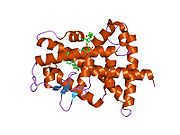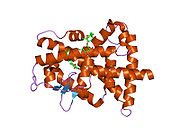- Retinoic acid receptor gamma
-
Retinoic acid receptor gamma (RAR-gamma), also known as NR1B3 (nuclear receptor subfamily 1, group B, member 3) is a nuclear receptor encoded by the RARG gene.[1][2]
Contents
Interactions
Retinoic acid receptor gamma has been shown to interact with NCOR1.[3]
See also
References
- ^ "Entrez Gene: RARG retinoic acid receptor, gamma". http://www.ncbi.nlm.nih.gov/sites/entrez?Db=gene&Cmd=ShowDetailView&TermToSearch=5916.
- ^ Lehmann JM, Hoffmann B, Pfahl M (February 1991). "Genomic organization of the retinoic acid receptor gamma gene". Nucleic Acids Res. 19 (3): 573–8. doi:10.1093/nar/19.3.573. PMC 333650. PMID 1849262. http://www.pubmedcentral.nih.gov/articlerender.fcgi?tool=pmcentrez&artid=333650.
- ^ Dowell P, Ishmael JE, Avram D, Peterson VJ, Nevrivy DJ, Leid M (May 1999). "Identification of nuclear receptor corepressor as a peroxisome proliferator-activated receptor alpha interacting protein". J. Biol. Chem. 274 (22): 15901–7. doi:10.1074/jbc.274.22.15901. PMID 10336495.
Further reading
- Leid M, Kastner P, Lyons R et al. (1992). "Purification, cloning, and RXR identity of the HeLa cell factor with which RAR or TR heterodimerizes to bind target sequences efficiently". Cell 68 (2): 377–95. doi:10.1016/0092-8674(92)90478-U. PMID 1310259.
- Vollberg TM, Nervi C, George MD et al. (1992). "Retinoic acid receptors as regulators of human epidermal keratinocyte differentiation". Mol. Endocrinol. 6 (5): 667–76. doi:10.1210/me.6.5.667. PMID 1318502.
- Lehmann JM, Zhang XK, Pfahl M (1992). "RAR gamma 2 expression is regulated through a retinoic acid response element embedded in Sp1 sites". Mol. Cell. Biol. 12 (7): 2976–85. PMC 364511. PMID 1320193. http://www.pubmedcentral.nih.gov/articlerender.fcgi?tool=pmcentrez&artid=364511.
- Mattei MG, Rivière M, Krust A et al. (1991). "Chromosomal assignment of retinoic acid receptor (RAR) genes in the human, mouse, and rat genomes". Genomics 10 (4): 1061–9. doi:10.1016/0888-7543(91)90199-O. PMID 1655630.
- Kastner P, Krust A, Mendelsohn C et al. (1990). "Murine isoforms of retinoic acid receptor gamma with specific patterns of expression". Proc. Natl. Acad. Sci. U.S.A. 87 (7): 2700–4. doi:10.1073/pnas.87.7.2700. PMC 53758. PMID 2157210. http://www.pubmedcentral.nih.gov/articlerender.fcgi?tool=pmcentrez&artid=53758.
- Giguère V, Shago M, Zirngibl R et al. (1990). "Identification of a novel isoform of the retinoic acid receptor gamma expressed in the mouse embryo". Mol. Cell. Biol. 10 (5): 2335–40. PMC 360581. PMID 2157970. http://www.pubmedcentral.nih.gov/articlerender.fcgi?tool=pmcentrez&artid=360581.
- Ishikawa T, Umesono K, Mangelsdorf DJ et al. (1990). "A functional retinoic acid receptor encoded by the gene on human chromosome 12". Mol. Endocrinol. 4 (6): 837–44. doi:10.1210/mend-4-6-837. PMID 2172793.
- Krust A, Kastner P, Petkovich M et al. (1989). "A third human retinoic acid receptor, hRAR-gamma". Proc. Natl. Acad. Sci. U.S.A. 86 (14): 5310–4. doi:10.1073/pnas.86.14.5310. PMC 297611. PMID 2546152. http://www.pubmedcentral.nih.gov/articlerender.fcgi?tool=pmcentrez&artid=297611.
- Renaud JP, Rochel N, Ruff M et al. (1996). "Crystal structure of the RAR-gamma ligand-binding domain bound to all-trans retinoic acid". Nature 378 (6558): 681–9. doi:10.1038/378681a0. PMID 7501014.
- Zhou L, Pang J, Munroe DG, Lau C (1993). "A human retinoic acid receptor gamma isoform is homologous to the murine retinoic acid receptor gamma 7". Nucleic Acids Res. 21 (10): 2520. doi:10.1093/nar/21.10.2520. PMC 309563. PMID 7685085. http://www.pubmedcentral.nih.gov/articlerender.fcgi?tool=pmcentrez&artid=309563.
- Zitnik RJ, Kotloff RM, Latifpour J et al. (1994). "Retinoic acid inhibition of IL-1-induced IL-6 production by human lung fibroblasts". J. Immunol. 152 (3): 1419–27. PMID 8301142.
- Botling J, Castro DS, Oberg F et al. (1997). "Retinoic acid receptor/retinoid X receptor heterodimers can be activated through both subunits providing a basis for synergistic transactivation and cellular differentiation". J. Biol. Chem. 272 (14): 9443–9. doi:10.1074/jbc.272.14.9443. PMID 9083083.
- Lømo J, Smeland EB, Ulven S et al. (1998). "RAR-, not RXR, ligands inhibit cell activation and prevent apoptosis in B-lymphocytes". J. Cell. Physiol. 175 (1): 68–77. doi:10.1002/(SICI)1097-4652(199804)175:1<68::AID-JCP8>3.0.CO;2-A. PMID 9491782.
- Klaholz BP, Renaud JP, Mitschler A et al. (1998). "Conformational adaptation of agonists to the human nuclear receptor RAR gamma". Nat. Struct. Biol. 5 (3): 199–202. doi:10.1038/nsb0398-199. PMID 9501913.
- Zhang ZP, Gambone CJ, Gabriel JL et al. (1999). "Arg278, but not Lys229 or Lys236, plays an important role in the binding of retinoic acid by retinoic acid receptor gamma". J. Biol. Chem. 273 (51): 34016–21. doi:10.1074/jbc.273.51.34016. PMID 9852056.
- Yang C, Zhou D, Chen S (1999). "Modulation of aromatase expression in the breast tissue by ERR alpha-1 orphan receptor". Cancer Res. 58 (24): 5695–700. PMID 9865725.
- Nagpal S, Ghosn C, DiSepio D et al. (1999). "Retinoid-dependent recruitment of a histone H1 displacement activity by retinoic acid receptor". J. Biol. Chem. 274 (32): 22563–8. doi:10.1074/jbc.274.32.22563. PMID 10428834.
- Egea PF, Mitschler A, Rochel N et al. (2000). "Crystal structure of the human RXRα ligand-binding domain bound to its natural ligand: 9-cis retinoic acid". EMBO J. 19 (11): 2592–601. doi:10.1093/emboj/19.11.2592. PMC 212755. PMID 10835357. http://www.pubmedcentral.nih.gov/articlerender.fcgi?tool=pmcentrez&artid=212755.
- Boudjelal M, Voorhees JJ, Fisher GJ (2002). "Retinoid signaling is attenuated by proteasome-mediated degradation of retinoid receptors in human keratinocyte HaCaT cells". Exp. Cell Res. 274 (1): 130–7. doi:10.1006/excr.2001.5450. PMID 11855864.
PDB gallery 1dsz: STRUCTURE OF THE RXR/RAR DNA-BINDING DOMAIN HETERODIMER IN COMPLEX WITH THE RETINOIC ACID RESPONSE ELEMENT DR11exa: ENANTIOMER DISCRIMINATION ILLUSTRATED BY CRYSTAL STRUCTURES OF THE HUMAN RETINOIC ACID RECEPTOR HRARGAMMA LIGAND BINDING DOMAIN: THE COMPLEX WITH THE ACTIVE R-ENANTIOMER BMS270394.1exx: ENANTIOMER DISCRIMINATION ILLUSTRATED BY CRYSTAL STRUCTURES OF THE HUMAN RETINOIC ACID RECEPTOR HRARGAMMA LIGAND BINDING DOMAIN: THE COMPLEX WITH THE INACTIVE S-ENANTIOMER BMS270395.1fcx: ISOTYPE SELECTIVITY OF THE HUMAN RETINOIC ACID NUCLEAR RECEPTOR HRAR: THE COMPLEX WITH THE RARGAMMA-SELECTIVE RETINOID BMS1843941fcy: ISOTYPE SELECTIVITY OF THE HUMAN RETINOIC ACID NUCLEAR RECEPTOR HRAR: THE COMPLEX WITH THE RARBETA/GAMMA-SELECTIVE RETINOID CD5641fcz: ISOTYPE SELECTIVITY OF THE HUMAN RETINOIC ACID NUCLEAR RECEPTOR HRAR: THE COMPLEX WITH THE PANAGONIST RETINOID BMS1811561fd0: ISOTYPE SELECTIVITY OF THE HUMAN RETINOIC ACID NUCLEAR RECEPTOR HRAR: THE COMPLEX WITH THE RARGAMMA-SELECTIVE RETINOID SR112541hra: THE SOLUTION STRUCTURE OF THE HUMAN RETINOIC ACID RECEPTOR-BETA DNA-BINDING DOMAIN2lbd: LIGAND-BINDING DOMAIN OF THE HUMAN RETINOIC ACID RECEPTOR GAMMA BOUND TO ALL-TRANS RETINOIC ACID3lbd: LIGAND-BINDING DOMAIN OF THE HUMAN RETINOIC ACID RECEPTOR GAMMA BOUND TO 9-CIS RETINOIC ACID4lbd: LIGAND-BINDING DOMAIN OF THE HUMAN RETINOIC ACID RECEPTOR GAMMA BOUND TO THE SYNTHETIC AGONIST BMS961Transcription factors and intracellular receptors (1) Basic domains (1.1) Basic leucine zipper (bZIP)Activating transcription factor (AATF, 1, 2, 3, 4, 5, 6, 7) · AP-1 (c-Fos, FOSB, FOSL1, FOSL2, JDP2, c-Jun, JUNB, JUND) · BACH (1, 2) · BATF · BLZF1 · C/EBP (α, β, γ, δ, ε, ζ) · CREB (1, 3, L1) · CREM · DBP · DDIT3 · GABPA · HLF · MAF (B, F, G, K) · NFE (2, L1, L2, L3) · NFIL3 · NRL · NRF (1, 2, 3) · XBP1(1.2) Basic helix-loop-helix (bHLH)ATOH1 · AhR · AHRR · ARNT · ASCL1 · BHLHB2 · BMAL (ARNTL, ARNTL2) · CLOCK · EPAS1 · FIGLA · HAND (1, 2) · HES (5, 6) · HEY (1, 2, L) · HES1 · HIF (1A, 3A) · ID (1, 2, 3, 4) · LYL1 · MESP2 · MXD4 · MYCL1 · MYCN · Myogenic regulatory factors (MyoD, Myogenin, MYF5, MYF6) · Neurogenins (1, 2, 3) · NeuroD (1, 2) · NPAS (1, 2, 3) · OLIG (1, 2) · Pho4 · Scleraxis · SIM (1, 2) · TAL (1, 2) · Twist · USF1(1.3) bHLH-ZIP(1.4) NF-1(1.5) RF-X(1.6) Basic helix-span-helix (bHSH)(2) Zinc finger DNA-binding domains (2.1) Nuclear receptor (Cys4)subfamily 1 (Thyroid hormone (α, β), CAR, FXR, LXR (α, β), PPAR (α, β/δ, γ), PXR, RAR (α, β, γ), ROR (α, β, γ), Rev-ErbA (α, β), VDR)
subfamily 2 (COUP-TF (I, II), Ear-2, HNF4 (α, γ), PNR, RXR (α, β, γ), Testicular receptor (2, 4), TLX)
subfamily 3 (Steroid hormone (Androgen, Estrogen (α, β), Glucocorticoid, Mineralocorticoid, Progesterone), Estrogen related (α, β, γ))
subfamily 4 NUR (NGFIB, NOR1, NURR1) · subfamily 5 (LRH-1, SF1) · subfamily 6 (GCNF) · subfamily 0 (DAX1, SHP)(2.2) Other Cys4(2.3) Cys2His2General transcription factors (TFIIA, TFIIB, TFIID, TFIIE (1, 2), TFIIF (1, 2), TFIIH (1, 2, 4, 2I, 3A, 3C1, 3C2))
ATBF1 · BCL (6, 11A, 11B) · CTCF · E4F1 · EGR (1, 2, 3, 4) · ERV3 · GFI1 · GLI-Krüppel family (1, 2, 3, REST, S2, YY1) · HIC (1, 2) · HIVEP (1, 2, 3) · IKZF (1, 2, 3) · ILF (2, 3) · KLF (2, 3, 4, 5, 6, 7, 8, 9, 10, 11, 12, 13, 14, 15, 17) · MTF1 · MYT1 · OSR1 · PRDM9 · SALL (1, 2, 3, 4) · SP (1, 2, 4, 7, 8) · TSHZ3 · WT1 · Zbtb7 (7A, 7B) · ZBTB (16, 17, 20, 32, 33, 40) · zinc finger (3, 7, 9, 10, 19, 22, 24, 33B, 34, 35, 41, 43, 44, 51, 74, 143, 146, 148, 165, 202, 217, 219, 238, 239, 259, 267, 268, 281, 295, 300, 318, 330, 346, 350, 365, 366, 384, 423, 451, 452, 471, 593, 638, 644, 649, 655)(2.4) Cys6(2.5) Alternating composition(3) Helix-turn-helix domains (3.1) HomeodomainARX · CDX (1, 2) · CRX · CUTL1 · DBX (1, 2) · DLX (3, 4, 5) · EMX2 · EN (1, 2) · FHL (1, 2, 3) · HESX1 · HHEX · HLX · Homeobox (A1, A2, A3, A4, A5, A7, A9, A10, A11, A13, B1, B2, B3, B4, B5, B6, B7, B8, B9, B13, C4, C5, C6, C8, C9, C10, C11, C12, C13, D1, D3, D4, D8, D9, D10, D11, D12, D13) · HOPX · IRX (1, 2, 3, 4, 5, 6, MKX) · LMX (1A, 1B) · MEIS (1, 2) · MEOX2 · MNX1 · MSX (1, 2) · NANOG · NKX (2-1, 2-2, 2-3, 2-5, 3-1, 3-2, 6-1, 6-2) · NOBOX · PBX (1, 2, 3) · PHF (1, 3, 6, 8, 10, 16, 17, 20, 21A) · PHOX (2A, 2B) · PITX (1, 2, 3) · POU domain (PIT-1, BRN-3: A, B, C, Octamer transcription factor: 1, 2, 3/4, 6, 7, 11) · OTX (1, 2) · PDX1 · SATB2 · SHOX2 · VAX1 · ZEB (1, 2)(3.2) Paired box(3.3) Fork head / winged helix(3.4) Heat Shock Factors(3.5) Tryptophan clusters(3.6) TEA domain(4) β-Scaffold factors with minor groove contacts (4.1) Rel homology region(4.2) STAT(4.3) p53(4.4) MADS box(4.6) TATA binding proteins(4.7) High-mobility group(4.10) Cold-shock domainCSDA, YBX1(4.11) Runt(0) Other transcription factors (0.2) HMGI(Y)(0.3) Pocket domain(0.6) Miscellaneoussee also transcription factor/coregulator deficiencies
B bsyn: dna (repl, cycl, reco, repr) · tscr (fact, tcrg, nucl, rnat, rept, ptts) · tltn (risu, pttl, nexn) · dnab, rnab/runp · stru (domn, 1°, 2°, 3°, 4°)Categories:- Human proteins
- Chromosome 12 gene stubs
- Intracellular receptors
- Transcription factors
Wikimedia Foundation. 2010.












